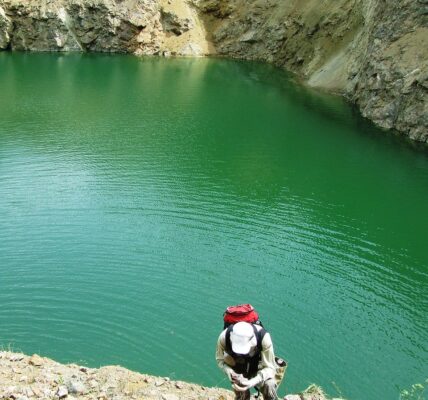They are formed as a result of magma cooling inside the Earth or occurring as volcanic lava. These are rocks with a variable proportion of crystallized matter and glassy matter (non-crystalline amorphous solids), acidic to basic pH and colors ranging from light to very dark tones.
Magmatic rocks form at points on Earth where the Earth’s crust is breaking up or new crust is forming. This is in subduction zones (where the old ocean floor sinks beneath the continents), or in mid-ocean ridges.
These areas underground reach temperatures above 1000 ºC, which melts rocks and minerals, becoming part of the magma. Rising to the surface, the magma cools and igneous or magmatic rocks are formed.
Igneous rocks are 59% feldspars, 17% amphiboles and pyroxenes, 12% quartz, 4% mica and 8% other minerals. There are some richer in silicon with little iron and magnesium (silicic) and others with more iron and magnesium than silica (ferromagnesian).
Its texture varies, determined by the ratio between crystal and glass, the size and shape of its particles and their arrangement among themselves. These rocks can be intrusive if they form when magma cools below the surface, and igneous if they come from lava.
Magmatic rocks make up about 95% of the rocks in the Earth’s crust, but they are less visible than sedimentary rocks. Among them are basalt, granite, obsidian and pumice, in addition to about 700 more described species.
Characteristics of igneous rocks
The general characteristics of igneous rocks are given by their origin, as they are the product of solidified magma. They are the only rocks derived from solidified liquid material.
Composition of magma
The type of igneous rock is determined by the composition of the magma and how and where it solidifies, with over 700 different types known. When the composition of the magma is dominated by iron and magnesium, mafic rocks are formed, and if silicon dioxide is predominant, felsic rocks are obtained.
Similarly, the proportion of silica oxide determines the pH of the igneous rock, and if it exceeds 65%, the rock will be acidic. While if it is between 45% and 65%, neutral rocks are obtained and below 45% they are basic.
The effect of cooling the magma
In addition, the cooling process by magma affects the resulting rock because under the crust, cooling is slower, creating more crystallization. If the magma is exposed to air and water as it rises as lava, it cools faster, glass transition occurs and glassy rocks (volcanic glass) can form.
Igneous rocks are formed from magma, a liquid composed of molten rock, suspended crystals and gases. This magma is found in the Earth’s mantle and is recycled during the process of crustal renewal in continental drift.
Magma rises from the deepest layers of the crust and solidifies, crystallizing to form igneous rocks beneath the crust. They undergo a slow cooling process that determines the type of crystallization, which is called fractional.
Therefore, at each stage of cooling (depending on temperature), some minerals crystallize and then others. Thus, magmatic rocks with large crystals and with a smaller proportion of glass emerge.
Sometimes magma can rise strongly to the surface through volcanic eruptions in the form of lava, cooling faster.For example, igneous rocks called Pele’s hair are formed when wind carries fragments of molten lava in suspension.
Sudden cooling of basaltic magma droplets or lava flows flowing into the sea can also occur. These igneous rocks have smaller crystals and a higher proportion of glass.
Continental drift, magma and igneous rocks
The Earth has a solid iron core surrounded by a molten phase and above this a mantle that has a first layer that goes from liquid to semi-solid and a solid upper layer (crust). This crust breaks down into plates that shift due to the motion generated by thermal convection beneath it.
The magma rises and comes out on mid-ocean ridges, which are volcanic ridges on the seafloor. There, the crust becomes thinner and magma emerges, forming a new ocean floor that pushes the old one, and when it collides with continental plates, it sinks, melting again.
In this process, rocks and minerals melt to form part of the magma that will reappear on continental ridges and volcanic areas. It is at these points that igneous rocks are formed when the magma cools.




